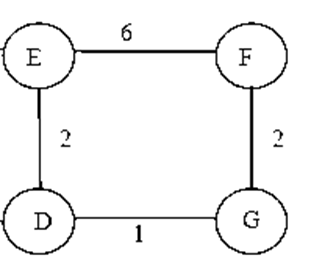is H. occurs in some MST The evidence is demonstrated in the next section. Assume the graph G in Figure 1 is correct.
Figure 1
The MST of the graph will be as shown in Figure 2.

Figure 2
Figure 3 is a subgraph H of graph G .
![]()

Figure 3
The MST of this graph will be as shown in Figure 4.
![]()

Figure 4
with H's shared edges will be contained. Figure 4 is role="math" localid="1658914214466" . Thus, .If somehow the weight for ED in Figure 1 was 6, then the weight of ED in Figure 2 would be 6. But there would have been two MST of H, one with the ED edge and the other with the EF edge. However, there'd have been two MST of G as well. In either scenario, every MST of H would contain the crossover of any T with H.
As a result, is always present in some H MST.





